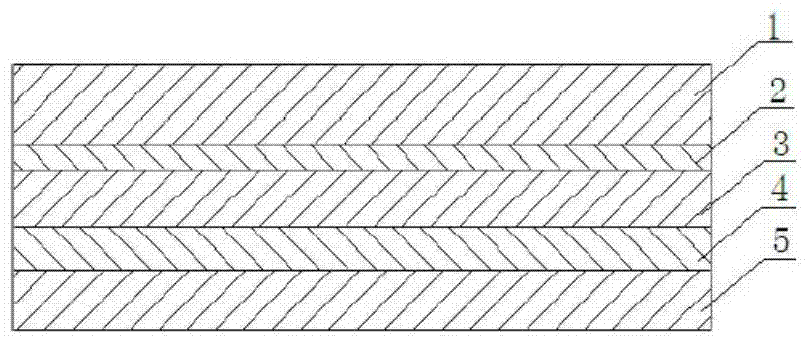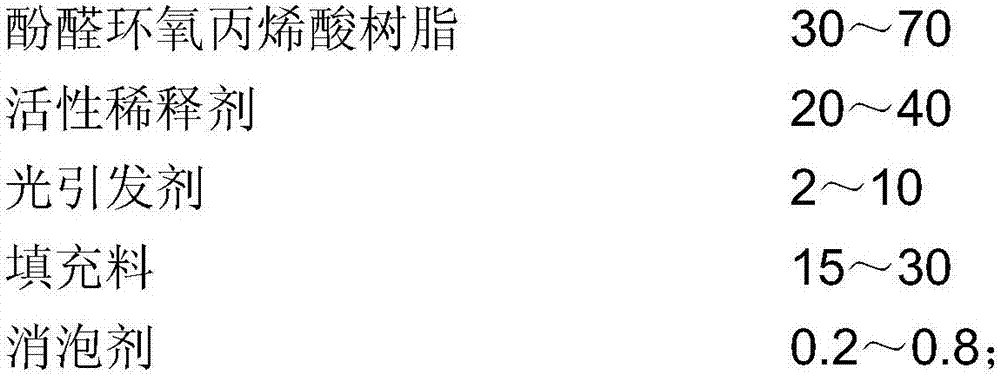A kind of anti-acid protective ink and preparation method thereof
An ink and acid-type technology, applied in the chemical industry, can solve the problems of easily corroded touch screen lines, poor hydrofluoric acid resistance, and a large amount of waste alkaline water, etc., to improve hydrofluoric acid resistance, high curing efficiency, Effect of increasing curing crosslink density
- Summary
- Abstract
- Description
- Claims
- Application Information
AI Technical Summary
Problems solved by technology
Method used
Image
Examples
Embodiment 1
[0029] Add 100 grams (0.61mol) of novolac epoxy resin (NPPN-638S), 0.2 grams of triphenylphosphine, and 0.26 grams of hydroquinone into the reactor, raise the temperature to 110°C, and add 38.2 grams (0.53mol) of AA and 219.5 The mixed solution of gram (1.06mol) AMPS was added dropwise slowly and continuously for 60 minutes with a constant pressure funnel, and after the dropwise addition was completed, it was kept at 115° C. for 2 hours to obtain a novolak epoxy acrylic resin.
[0030] Weigh the following raw materials in parts by weight: 50 parts of phenolic epoxy acrylic resin, 20 parts of 1,6-hexanediol diacrylate, 5 parts of 1-hydroxycyclohexyl phenyl ketone, 15 parts of talcum powder, and 10 parts of barium sulfate , 0.5 parts of defoamer. Mix epoxy acrylic resin with reactive diluent, add photoinitiator, filler, defoamer, and form a uniform viscous liquid after high-speed stirring. Put the viscous liquid into a grinder and grind it to get the finished protective ink.
Embodiment 2
[0032] Add 100 grams (0.61mol) of novolac epoxy resin (NPPN-638S), 0.2 grams of triphenylphosphine, and 0.26 grams of hydroquinone into the reactor, raise the temperature to 110°C, and add 38.2 grams (0.53mol) of AA and 219.5 The mixed solution of gram (1.06mol) AMPS was added dropwise slowly and continuously for 60 minutes with a constant pressure funnel, and after the dropwise addition was completed, it was kept at 115° C. for 2 hours to obtain a novolak epoxy acrylic resin.
[0033] Weigh the following raw materials in parts by weight: 50 parts of novolac epoxy acrylic resin, 20 parts of hydroxypropyl methacrylate, 5 parts of 1-hydroxycyclohexyl phenyl ketone, 15 parts of talcum powder, 10 parts of barium sulfate, defoamer 0.5 servings. Mix epoxy acrylic resin with reactive diluent, add photoinitiator, filler, defoamer, and form a uniform viscous liquid after high-speed stirring. Put the viscous liquid into a grinder and grind it to get the finished protective ink.
Embodiment 3
[0035] Add 100 grams (0.61mol) of novolac epoxy resin (NPPN-638S), 0.2 grams of triphenylphosphine, and 0.26 grams of hydroquinone into the reactor, raise the temperature to 110°C, and add 38.2 grams (0.53mol) of AA and 219.5 The mixed solution of gram (1.06mol) AMPS was added dropwise slowly and continuously for 60 minutes with a constant pressure funnel, and after the dropwise addition was completed, it was kept at 115° C. for 2 hours to obtain a novolak epoxy acrylic resin.
[0036] Weigh the following raw materials in parts by weight: 50 parts of novolac epoxy acrylic resin, 20 parts of 1,6-hexanediol diacrylate, 2-methyl-1-[4-(methylthio)phenyl]-2- 6 parts of morpholino-1-acetone, 3 parts of isopropylthioxanthone, 15 parts of talcum powder, 10 parts of barium sulfate, and 0.5 parts of defoamer. Mix epoxy acrylic resin with reactive diluent, add photoinitiator, filler, defoamer, and form a uniform viscous liquid after high-speed stirring. Put the viscous liquid into a grin...
PUM
| Property | Measurement | Unit |
|---|---|---|
| epoxy equivalent | aaaaa | aaaaa |
Abstract
Description
Claims
Application Information
 Login to View More
Login to View More - R&D
- Intellectual Property
- Life Sciences
- Materials
- Tech Scout
- Unparalleled Data Quality
- Higher Quality Content
- 60% Fewer Hallucinations
Browse by: Latest US Patents, China's latest patents, Technical Efficacy Thesaurus, Application Domain, Technology Topic, Popular Technical Reports.
© 2025 PatSnap. All rights reserved.Legal|Privacy policy|Modern Slavery Act Transparency Statement|Sitemap|About US| Contact US: help@patsnap.com



